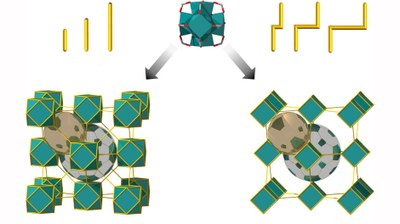The article provided the first-ever report on the use of zigzag ligands to create isoreticular Zr-bcu-MOFs (metal–organic frameworks). MOFs are a revolutionary class of materials constructed from metal ions/clusters and organic ligands that link together via self-assembly.
The linkers for metal-organic frameworks are usually bidentate molecules (for example, dicarboxylic acids) connected by an organic group to create a linear or, in some cases, a bent geometry like isophthalic acid. Scientists explored the effect of a “zigzag” linker, trans,trans-muconic acid (tmuc), that forces an offset of inorganic building blocks. Reaction with ZrCl4 formed the metal-organic framework Zr6O4(OH)4(tmuc)8(H2O)8, which had an eight-connected bcu topology, a subset of the 12-connected fcu topology seen with linear linkers. This bcu topology was maintained with linkers of even larger transversal width, such as azobenzene-3,3′-dicarboxylic acid.

Topological influence of zigzag ligands in the assembly of Zr(IV) metal–organic frameworks (MOFs). Through a transversal design strategy using reticular chemistry, it wa been able to synthesize a family of isoreticular Zr(IV)-based MOFs exhibiting the bcu—rather than the fcu—topology. The findings underscore the value of the transversal parameter in organic ligands for dictating MOF architectures.
- Science Magazine highlight
- Reference: Vincent Guillerm, Thais Grancha, Inhar Imaz, Judith Juanhuix, and Daniel Maspoch. Zigzag Ligands for Transversal Design in Reticular Chemistry: Unveiling New Structural Opportunities for Metal–Organic Frameworks. J. Am. Chem. Soc., July 31, 2018, 140 (32), pp 10153–10157. DOI: 10.1021/jacs.8b07050




